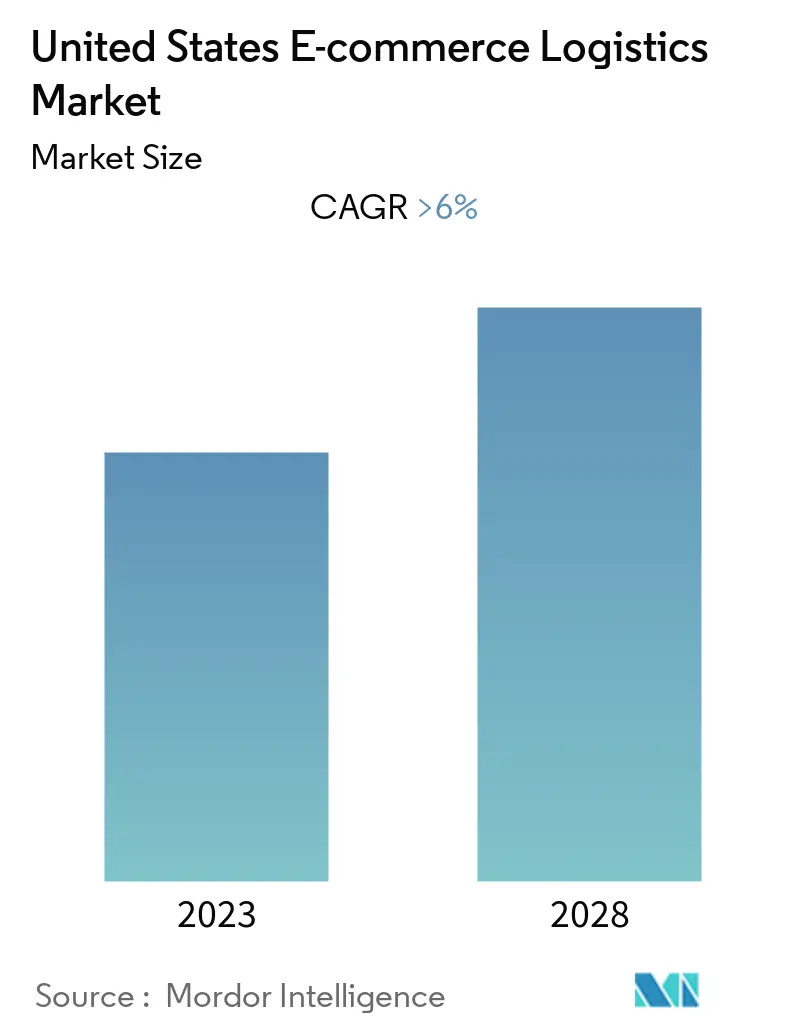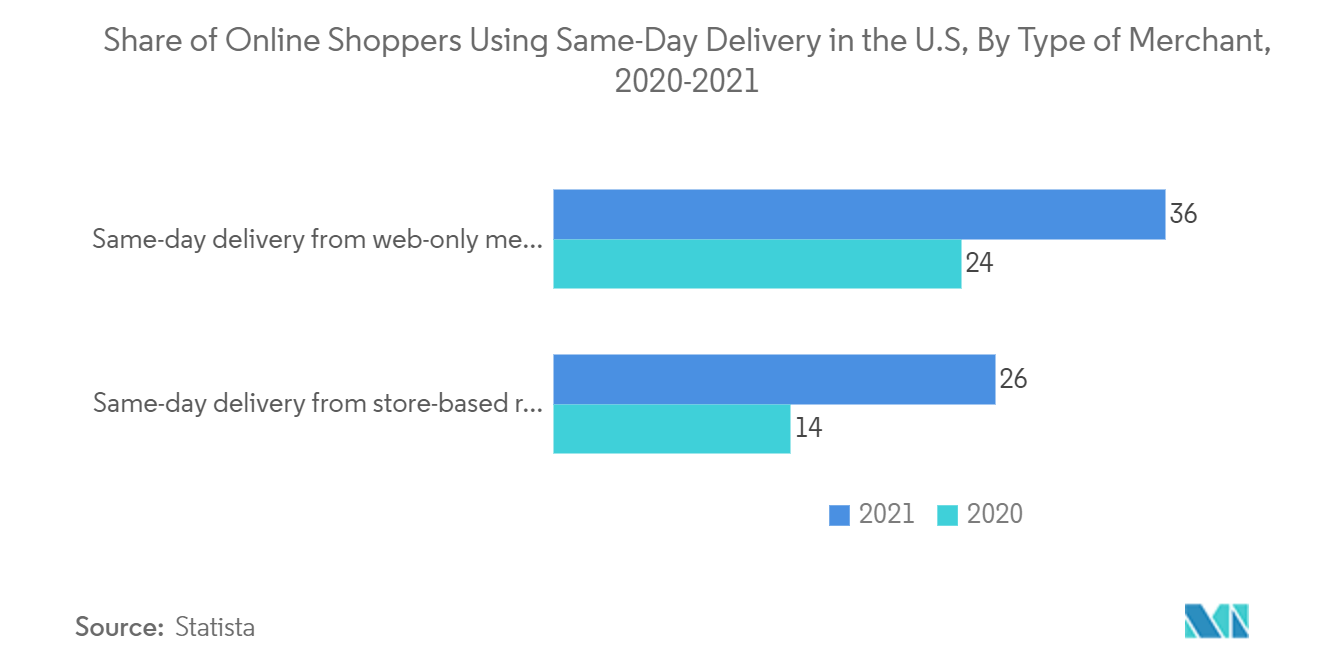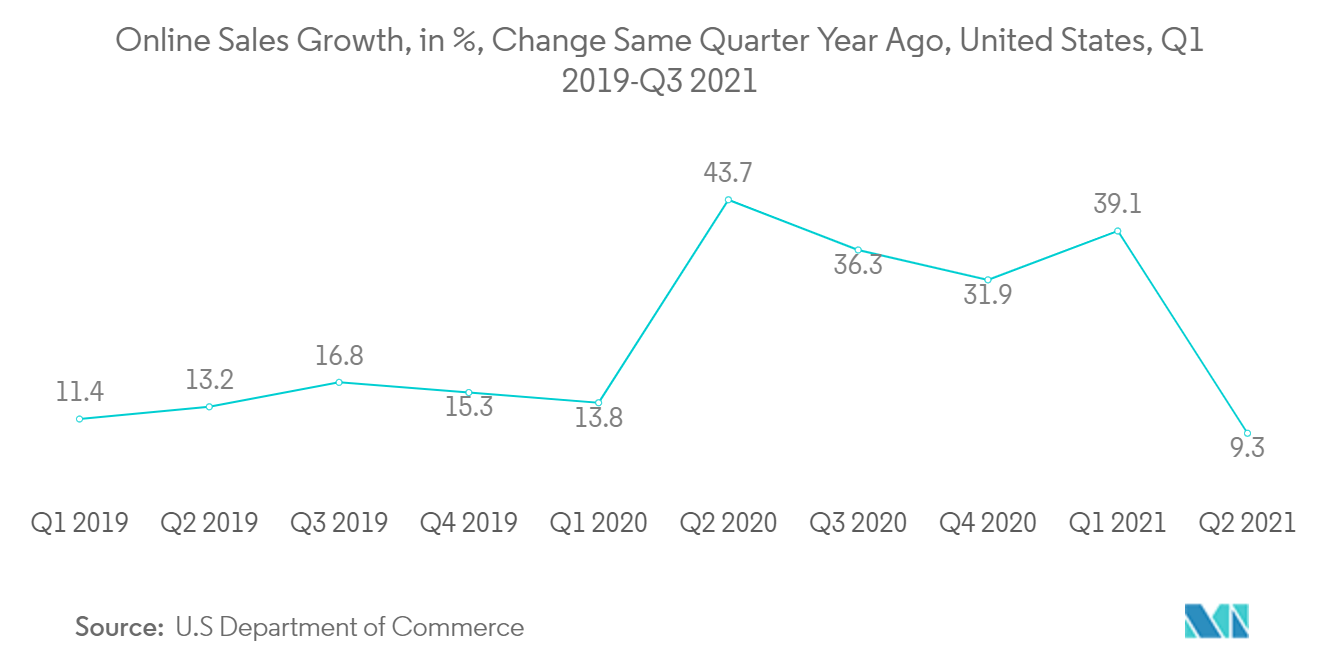US E-Commerce Logistics Market Size

| Study Period | 2019 - 2028 |
| Base Year For Estimation | 2021 |
| Forecast Data Period | 2024 - 2028 |
| Historical Data Period | 2019 - 2020 |
| CAGR | > 6.00 % |
| Market Concentration | Low |
Major Players.webp)
*Disclaimer: Major Players sorted in no particular order |
Need a report that reflects how COVID-19 has impacted this market and its growth?
US E-Commerce Logistics Market Analysis
US e-commerce logistics market is estimated to grow significantly at a CAGR of more than 6% during the forecast period.
Before COVID-19, e-commerce was already on the rise. According to a recent examination of statistics from the US Department of Commerce, whereas brick-and-mortar retail hasn't gained more than 4% since 2005, US online sales have grown at a steady annual rate of between 13% and 18% over the last decade. B2C e-commerce sales grew in 2020 due to an increase in online shopping activity during the COVID-19 outbreak in the United States.
The US holds a major share in the North American e-commerce logistics market owing to the advancement in logistics technologies attributed to the introduction of automation, robotics, wearable technology, drone technology, self-driving vehicles, cloud computing, and IoT in logistics technology.
United States is the world's largest economy with a GDP of more than USD 20 trillion and with a population and consumer base of more than 315 million. But despite the seemingly unquenchable demand, the same-day delivery market has its fair share or hurdles to overcome. For one, there’s a a driver shortage going on – last-mile firms are calling it their main concern, and many companies trying to get into same-day services are having to offer greater pay and benefits to their drivers to incentivize them to stay.
Smaller same-day providers are also constrained by a lack of automation technology and fulfillment locations. One of the challenges for same-day delivery is routing and dispatching for on-demand orders – without automation technology that can manage an entire fleet in real-time, it can be difficult to plan out the logistics of each delivery.
US E-Commerce Logistics Market Trends
This section covers the major market trends shaping the US E-Commerce Logistics Market according to our research experts:
Same Day Delivery Driving the Market
Same-day delivery has the potential to alter consumer purchasing habits. It combines the ease of online shopping with the immediate gratification of physical stores. In recent years, some of the world's leading logistics companies, including DHL, FedEx, and UPS, have begun testing and operating new same-day delivery models.
The same-day delivery market in the United States has grown over the years, owing to the fact that major players serve the majority of the area. same-day delivery in e-commerce is quickly becoming one of the most popular services in the United States, particularly in grocery and pharmacies.
The growing B2C e-commerce market in the US is driving the same-day delivery market growth. This industry accounted for a major share of overall retail sales. The B2C e-commerce segment is gaining prominence in the US because of the increasing Internet penetration and online shopping.
Between 2020 and 2021, the use of same-day delivery increased in the United States. This was more often the case for orders shipped by web-only merchants, and less frequent for store-based retailers. According to a survey, 24 percent of U.S. online shoppers opted for same-day delivery for purchases from pure online merchants in 2020. As of February 2021, the percentage increased to 36 percent.
Amazon and other e- commerce giants are expanding their same-day delivery services. Amazon recently announced a same-day delivery service to a half-dozen additional US cities in August 2021. The service, which the retailer has been working on for the past year to make same-day delivery even faster, now allows consumers in a number of markets to shop up to 3 million items on Amazon.com and receive their orders in just a few hours. Amazon invested in what it called "mini-fulfillment centers" closer to where customers lived in selected US markets, initially in Philadelphia, Phoenix, Orlando, and Dallas, to reach customers faster.
Faster same-day delivery has been one of the most significant services Amazon has used to compete with rivals such as Walmart and Target, both of which benefit from having a large brick-and-mortar footprint that allows them to serve their customers more quickly through same-day order pickup, curbside pickup, and same-day delivery services.

Growing Preference for offline Shopping Post Pandemic May Impede Market Growth
According to US Department of Commerce estimates, e-commerce growth slowed dramatically year over year in the second quarter of 2021 after a year of large online shopping spikes as COVID-19 took hold in the US.
The deceleration in consumer spending was expected because Q2 2021 benchmarks against the peak of online pandemic shopping in the same period in 2020. In addition, as more Americans received the vaccine in Q2 and coronavirus infections decreased, buyers returned to physical stores and moved some of their spending from ecommerce sites to the brick-and-mortar channel. Since the Great Recession in 2008, the 9.3% increase was the weakest year-over-year growth rate of any quarter or year.
As more shoppers flocked to the stores in 2021, offline sales surged 22.2% for the quarter, the highest-ever recorded gain for the channel. In Q2 2021, offline retail grew at a rate more than double that of e-commerce, resulting in a dip in penetration.
Because many physical businesses were shuttered, offline retail decreased by 4.4% in Q2 2020. The record increase in retail expenditure in 2021 signaled a significant comeback in overall spending, which had only climbed by 2.6% in Q2 2020 as online gains completely offset declining store sales. Digital sales, on the other hand, accounted for only 9.3% of total retail gains in the second quarter of 2021.

US E-Commerce Logistics Industry Overview
The competitive landscape of the United States e-commerce logistics market is observed to be fragmented, as the demand for logistics services is growing rapidly across the region, companies are becoming more competitive to capture the huge opportunity. As a result, international players are making strategic investments to establish a regional logistics network, such as opening new distribution centers, smart warehouses, etc. Some of the leading players include Amazon, DHL, UPS Supply Chain Solutions, XPO Logistics, DB Schenker, SF Express, etc.
US E-Commerce Logistics Market Leaders
DHL Logsitics
FedEx
UPS Supply Chain Solutions
XPO Logistics
DB Schenker
*Disclaimer: Major Players sorted in no particular order

US E-Commerce Logistics Market News
March 2022: DHL Supply Chain (a freight and logistics company) rolled out a strategic partnership with ReverseLogix (one of the leading cloud-based platforms to automate end-to-end reverse logistics for e-commerce brands). The decision came at a time when DHL Supply Chain continues, to see impressive growth, for its e-commerce business, which saw a 15% annual growth rate over the 2021 peak season, coupled with total national retail returns climbing 78%, to more than USD 761 billion.
March 2022: FedEx Office, a world-class provider of convenient, state-of-the-art printing, packing, and shipping services and a subsidiary of FedEx Corp, announced an alliance with Notarize, a leading online notarization provider, to launch FedEx Office Online Notary. The new service will make convenient, fully digital notarization services available to the millions of Americans who need personal or professional documents notarized annually.
US E-Commerce Logistics Market Report - Table of Contents
1. INTRODUCTION
1.1 Study Deliverables
1.2 Study Assumptions
1.3 Scope of the Study
2. RESEARCH METHODOLOGY
3. EXECUTIVE SUMMARY
4. MARKET INSIGHTS
4.1 Current Market Scenario
4.2 Technological Trends in the Industry
4.3 Government Initiatives and Regulations
4.4 Insights on the E-commerce Market
4.5 Insights on Reverse/Return Logistics
4.6 Impact of COVID-19 on the Market
5. MARKET DYNAMICS
5.1 Market Drivers
5.2 Market Restraints / Challenges
5.3 Market Opportunities
5.4 Porter's Five Forces Analysis
5.4.1 Threat of New Entrants
5.4.2 Bargaining Power of Buyers/Consumers
5.4.3 Bargaining Power of Suppliers
5.4.4 Threat of Substitute Products
5.4.5 Intensity of Competitive Rivalry
6. MARKET SEGMENTATION
6.1 By Service
6.1.1 Transportation
6.1.2 Warehousing and Inventory management
6.1.3 Value-added services (Labeling, Packaging, etc)
6.2 By Business
6.2.1 B2B
6.2.2 B2C
6.3 By Destination
6.3.1 Domestic
6.3.2 International/cross-border
6.4 By Product
6.4.1 Fashion and Apparel
6.4.2 Consumer Electronics
6.4.3 Home Appliances
6.4.4 Furniture
6.4.5 Beauty and Personal Care Products
6.4.6 Other Products (Toys, Food Products, etc.)
7. COMPETITIVE LANDSCAPE
7.1 Market Concentration Overview
7.2 Company Profiles
7.2.1 DHL Logistics
7.2.2 FedEx
7.2.3 DB Schenker
7.2.4 XPO Logistics
7.2.5 UPS Supply Chain Solutions
7.2.6 Geodis Logistics
7.2.7 Saddle Creek Logistics
7.2.8 Rakuten Super Logistics
7.2.9 Kenco Logistics Services
7.2.10 Kuehne and Nagel Logistics*
- *List Not Exhaustive
8. FUTURE OF THE MARKET
9. APPENDIX
10. DISCLAIMER ABOUT US
US E-Commerce Logistics Industry Segmentation
The term "E-commerce logistics" refers to the transportation, warehousing, and distribution services provided to an online retailer by the logistics company. The United States E-Commerce Logistics Market is segmented By Service (Transportation, Warehousing and Inventory Management, and Value-added Services (Labeling, Packaging, etc.)), By Business (B2B and B2C), By Destination (Domestic and International/Cross-border), By Product (Fashion and Apparel, Consumer Electronics, Home Appliances, Furniture, Beauty and Personal Care Products, and Other Products (Toys, Food Products, etc.)). The report offers market size and forecast in value (USD Billion) for all the above segments. The impact of COVID-19 will also be covered in the report.
| By Service | |
| Transportation | |
| Warehousing and Inventory management | |
| Value-added services (Labeling, Packaging, etc) |
| By Business | |
| B2B | |
| B2C |
| By Destination | |
| Domestic | |
| International/cross-border |
| By Product | |
| Fashion and Apparel | |
| Consumer Electronics | |
| Home Appliances | |
| Furniture | |
| Beauty and Personal Care Products | |
| Other Products (Toys, Food Products, etc.) |
US E-Commerce Logistics Market Research FAQs
What is the current United States E-commerce Logistics Market size?
The United States E-commerce Logistics Market is projected to register a CAGR of greater than 6% during the forecast period (2023-2028).
Who are the key players in United States E-commerce Logistics Market?
DHL Logsitics, FedEx, UPS Supply Chain Solutions, XPO Logistics and DB Schenker are the major companies operating in the United States E-commerce Logistics Market.
United States E-commerce Logistics Industry Report
Statistics for the 2023 United States E-commerce Logistics market share, size and revenue growth rate, created by Mordor Intelligence™ Industry Reports. United States E-commerce Logistics analysis includes a market forecast outlook to 2028 and historical overview. Get a sample of this industry analysis as a free report PDF download.
